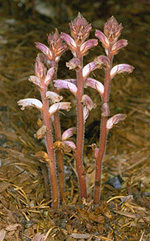 |
This specialised family of root parasites is found in all continents except Antarctica, from the tropics to the boreal and southern-temperate regions. In Australia a single native species and several introduced ones are found in the south-eastern and south-western temperate regions, in open woodlands to grasslands, occasionally in gardens.
Characteristic features of the family Orobanchaceae in Australia include: - root-parasitic herbs lacking well-developed leaves and chlorophyll, consisting of several scaly, erect, stout, fleshy stems arising from a swollen, underground tuber
- flowers brownish, cream or purplish, forming crowded, stout spikes at the ends of the erect stems.
- corolla strongly zygomorphic, 2-lipped with the upper lip somewhat hooded and the lower 3-lobed
- stamens 4, unequal
- ovary superior, developing into a capsule with numerous, dust-like seeds
Description
Perennial or annual terrestrial herbs. Perennating by tubers. Vegetative reproduction absent or by tubers. Plants totally parasitic on the roots of the host; chlorophyll absent and the plants colourless, white or yellowish. Stem internodes solid, spongy or pithy, succulent or fleshy, terete. Internal secretions not obvious. Plants glabrous, or with simple, glandular or non-glandular, uniseriate hairs. Leaves alternate, reduced to scales, cauline, sessile. Stipules absent. Lamina simple, symmetric, linear, ovate, lanceolate, elliptic or oblong; base cuneate; margin entire, ±flat; venation not obvious, with the midrib conspicuous, and conspicuous cross veins absent; surfaces not punctate; herbaceous, membranous or papery. All the flowers bisexual. Inflorescences terminal, consisting of spikes or racemes, or rarely solitary flowers. Bracts present. Bracteoles absent or apparently present. Pollination by insects. Flowers odourless, sessile. Perianth irregular, with distinct calyx and corolla. Calyx segments fused into a distinct cup or fused at extreme base only, with (2–) 4–5 lobes, valvate or open in bud; calyx cup-shaped, herbaceous or papery. Corolla segments fused, with 5 lobes, alternating with the calyx lobes or with no clear relationship to them, imbricate in bud; corolla funnel-shaped or curved-tubular, 2-lipped, thin and membranous, white, cream, pink, purple, magenta, violet or brown, without contrasting markings, or bicolorous and streaked; lobes more or less entire. Fertile stamens 4, in two unequal pairs, opposite to or with no clear relationship to the calyx lobes, at least partly fused to the corolla, free of the ovary and style, distinct from each other. Anthers dorsifixed, not versatile, opening inwards by short slits or longitudinal slits, 2-celled; appendages basal. Ovary superior. Carpels 2, fused; ovary with 1 locule. Style terminal, single, branched above. Ovules numerous per locule; stalked; placentation parietal. Fruit a dry dehiscent loculicidal capsule; the perianth on the maturing fruit dry and persistent or growing larger. Disseminule micro-surface alveolate, rugose or ±winged, yellow, brown, grey or black, glossy or dull. Seeds more than 10 per fruit. Aril absent. Cotyledons 0. Embryo shapeless.
(Note: this description has been generated from the coded data compiled for the key. Any errors in the key data will be reflected in the descriptions.)
A treatment of the family Orobanchaceae has not yet been published in the Flora of Australia. It will appear in Volume 33.
Australian genera of Orobanchaceae (as recognised for the Flora of Australia)
† = some species native, others introduced
†Orobanche

|
  |

Orobanche minor (flowering plant)
Photo: M.Fagg © ANBG

Orobanche minor (flowering plants)
Photo: M.Fagg © ANBG

Orobanche sp. (flowering plant)
Photo: M.Fagg © ANBG
|

| |